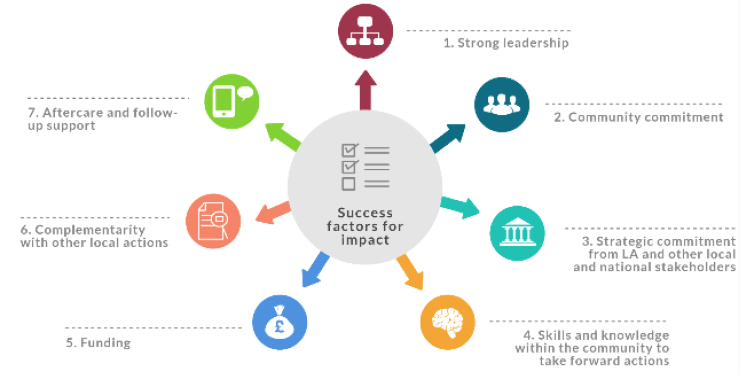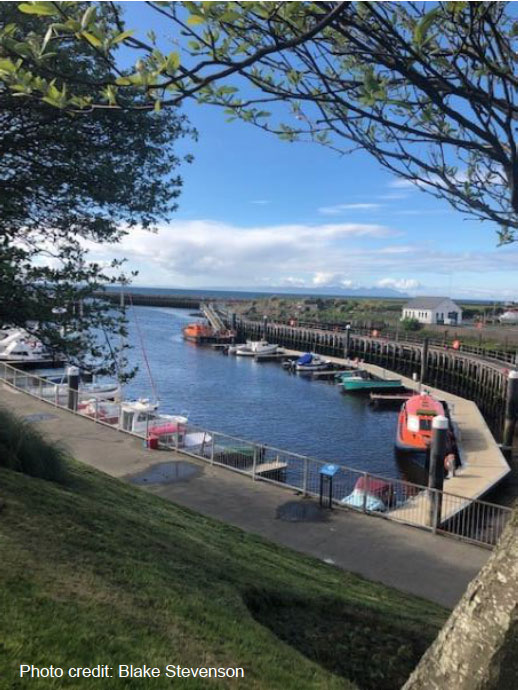Community-led design initiatives: evaluation
Findings from an evaluation of community–led design initiatives funded by the Scottish Government: the Charrette Mainstreaming Programme and the Making Places initiative.
6. Conclusions
The purpose of this evaluation was to establish whether and how the Programme has achieved its aims to date, the extent to which outputs arising from the design events have been implemented, assess the short and longer-term impact of the Programme, and to identify learning points to inform future development of the Programme.
The evaluation examined whether design events have been an effective mechanism for engaging and empowering local communities, and the extent to which they have changed practice in relation to planning for place. It also examined the effectiveness of the Programme in achieving longer-term outcomes for communities and project partners.
Across the sample projects examined, delivery of design events has been of a high standard with participants confirming good quality facilitation, the accessibility of venues and information, and events that have enthused and engaged. While quality across the wider programme is reported to have been more mixed, with some research participants describing the quality of events in some other areas they experienced as poorer, the consensus from research participants was that this was a valuable and effective programme that is significantly improving community engagement in relation to the design of places and that has the potential to continue to impact positively in future.
6.1 Effectiveness of the programme in encouraging and empowering community involvement in the design of places
A key tenet of the Scottish Government's community-led design programme is to place local communities at the centre of the design process. Through design events, Scottish Government has set out to involve communities in decision-making processes and encouraged them to play an active role in developing ideas for the future of their towns, villages and neighbourhoods.
The evaluation explored with local people their experiences of taking part in design events, and the extent to which the events led to them feeling more empowered to take part and to be influential in the design processes for their local areas.
Overwhelmingly, research participants found the design events themselves to be inspiring and empowering. Participation in the events was often believed to be wider than participation in previous community engagement events, with a strong sense that a cross-section of the community was involved.
External organisations involved in providing facilitation support were widely praised for the quality of their input, and activities delivered at the design events were often described as varied, inclusive and suited to all age ranges.
Research participants reported feeling that they were able to actively contribute at these events, and that there was real scope to influence future planning and design for their area. Some were enthused to become more involved in improving their local area as a result of taking part in the Programme.
Where they work well, design events have given the community a strong voice in the design of their local area and have resulted in local authorities embedding community engagement more effectively in their planning processes.
6.2 Effectiveness of the Programme in achieving longer-term outcomes for communities and project partners
All of the sample projects examined in depth demonstrated short-term outcomes, including smaller-scale improvements to the aesthetics of local areas, creation of new local groups, and increased membership of local groups. These were an important means of signalling to communities that their input to design events was valued and that action was being taken to deliver on priority actions agreed. Delivering these short-term outcomes was important in maintaining momentum following an event.
The Programme has also been highly effective in achieving longer-term impact in some (but not all) areas – this included impact on local physical infrastructure, local capacity, and community cohesion. This was more often, but not exclusively, the case in areas which were already rich in local assets i.e. engaged local people with the skills and knowledge to support improvements to their area.
In some areas, however, the impact of the Programme has been far less substantive and less strategic. This has most commonly been a result of a combination of apathy within the community, a lack of local capacity to take forward actions, and a lack of engagement by the local authority and other local organisations in relation to implementation.
6.3 Key factors for achieving impact
As discussed in Chapter 5, the evaluation identified a number of factors for success. Successful achievement of impact seems to be affected particularly by the factors shown in Figure 6.1 below:
Figure 6.1: Key factors for achieving impact

The size of an area or whether an area is urban or rural does not appear to be a determinant of success – pride in place, as well as an active and engaged local community is much more likely to determine success. Areas that saw the most impact from the Programme had often been in a better place to start off with – with a strong sense of local pride, active and engaged members of the community with skills and knowledge, as well as joined-up local agencies.
Where the enablers shown in Figure 6.1 are present, success in implementation and subsequent achievement of impact is much more likely. Where these enablers are less evident, it is likely that local communities will need more support to achieve the same impact.
These findings are in line with the findings of other research examined as part of a brief literature review conducted as part of this evaluation. The literature review confirmed the findings that design events vary in terms of a number of factors, such as cost, format, duration, and approach; that pre-engagement and awareness raising is crucial to participation rates; that they can strengthen local people's voices; and that their success can vary depending on the differing resources available to local communities. Further details can be found in the full literature review in Appendix 2.
6.4 Sustaining the impact of design events
The timing and status of the final reports varied across projects. In some instances they were commissioned by the local authority to inform the development plan process, sometimes they pre-dated this process, and sometimes they were commissioned subsequently. Although there was no official status of the report and no obligation on the part of the local authority to take notice of the final reports produced, many were used in the development plan process. The status and impact of design events led directly by the community is more uncertain and generally relied on some cooperation in advance of the design process. Ensuring that these final reports are seriously considered in development plan processes has been a common challenge – and their status is influenced by the level of local buy-in, and by who has commissioned the work. However, with the passing of the Planning Act (2019), these reports can be included as part of the process as a Local Place Plan.
Where they currently work well, the design events have been shown to give the community a strong voice in the design of their local area and have resulted in local authorities embedding community engagement in their planning processes. In some places, design events have already become an important catalyst for improving, planning and creating a better sense of place and there is a sense that this impact could be realised more widely.
Over the course of the Programme, the Scottish Government has been responsive to learning about what worked well and less well, adapting the Programme accordingly. The new Investing in Communities Fund, part of the Empowering Communities Fund, is a further development of the Programme. This new fund aims to promote a more responsive, community-led place based approach, one that is flexible and can adapt to existing and emerging community issues, circumstances and priorities; and that encourages more effective strategic place based partnership working. In so doing, it aims to support the best and most effective use of resources available to and within communities.The fund aims to help support disadvantaged communities to develop and deliver sustainable local solutions that address local priorities and needs; increase active inclusion; and build on the assets of local communities, which should address a number of the issues identified by this evaluation. Significantly, the new programme offers multi-year funding, taking account of the need for longer-term planning for some projects; can fund projects of up to £250,000 in value, and can be used to fund activity that has already been designed.
It is important that communities continue to have access to funding and support to take forward community design events, enabling community-led design to be further embedded in planning processes. This new fund is a good opportunity to build on the successful work undertaken through the Programme to date. The key learning points in the next chapter may provide helpful learning in taking forward the new fund.

Contact
There is a problem
Thanks for your feedback